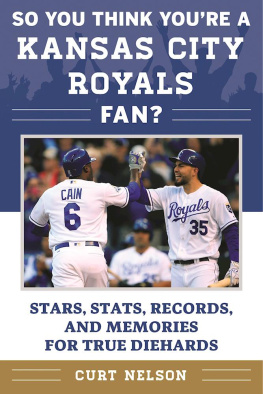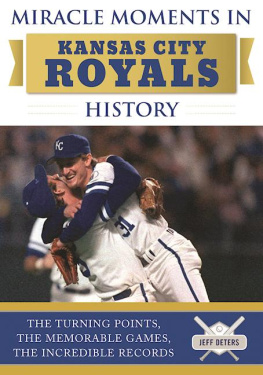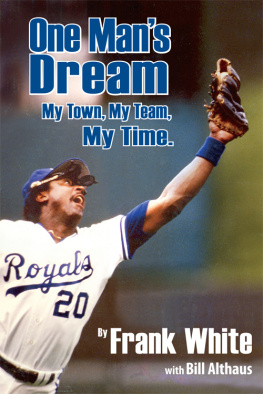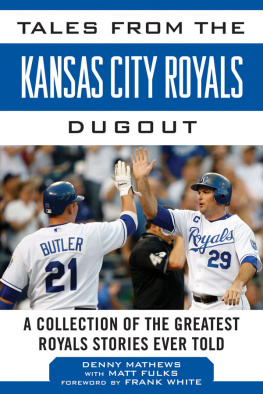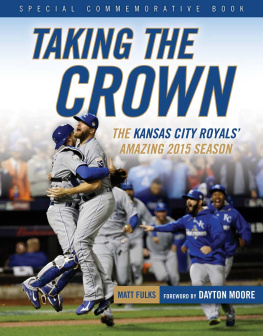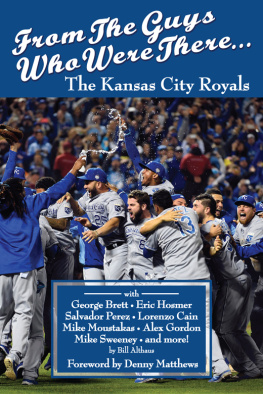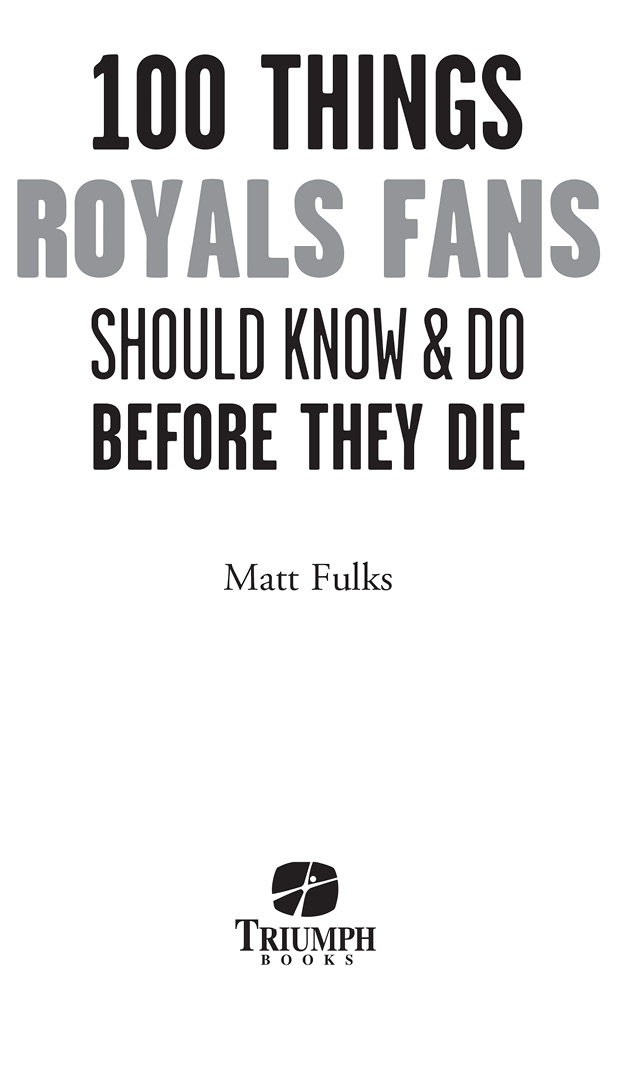To Helen, Charlie, and Aaron, may you grow up with the same love of the Royals that your grandparents and great-grandparents instilled in me.
Contents
Foreword by Jeff Montgomery
Kansas City has a special baseball tradition, and its a great honor to think that Ive played some part in that tradition. Growing up in Ohio, with the Reds as my team and then getting the opportunity to start my professional career with Cincinnati, I didnt fully understand the history and tradition of baseball in Kansas City.
So when the Reds traded me to the Royals before the 1988 season, I just knew it was going to be a situation in which I could become an immediate member of the rotation. I knew of Dan Quisenberry, George Brett, Bo Jackson, and Bret Saberhagen, but that was about it. I hadnt heard of guys like Buddy Black and Mark Gubicza. Whos Jerry Don Gleaton? Whos Tom Gordon? I felt pretty confident that Id make this club. I was a huge National League fan and didnt pay any attention to the American League. I quickly learned about the special baseball traditionand talentthat exists in Kansas City.
Within 20 minutes of reporting to the Royals camp, I met a guy who looked like he was either a media type or a front-office type. Sure enough, it was general manager John Schuerholz. He said, Welcome aboard; were glad to have you here. We looked at your numbers as a starter and as a reliever. We really like you more as a reliever, so were going to send you to Omaha to start the season and get some more experience as a reliever. My bubble burst immediately.
I became excited, though, once I found out that Gubicza, Black, and Charlie Leibrandt were established pitchers and, along with Saberhagen, made a great rotation. I ended up pitching really well in spring training and made it difficult for them to send me down, but they had Quisenberry and Gene Garber competing for the closers job. I dont think either one gave up a run during the entire spring training, so they kept both of them. When the season started, they both struggled to get guys out. In early June I got my first call up to the Royals.
Once I arrived in Kansas City, Saberhagen and Gubicza became great influences on me, and right along with them was reliever Steve Farr. When I was first called up, my third game was a save situation against the Oakland As. I had a 1-2-3 ninth, retiring Walt Weiss, Doug Jennings, and Carney Lansford. I only got one more save opportunity the rest of the year. Meanwhile, Steve was getting the save opportunities. He asked me one time, Do you want to know why I was getting all those save chances? Its because I went into [manager] John Wathans office and told him that Id been setting up Quiz for so many years that I deserved the chance. He started the next season as the closer but injured his knee. I had been pitching well, so I was put into the closers role during the second half. That probably ended up being my best season, start to finish. I ended the year with a 73 record, 18 saves, and a 1.37 ERA.
At the end of the season, Wathan called me into his office and said, Youve done a really nice job for us, and were looking forward to bigger and better things from you next year. Guess what? That offseason I turned on ESPN, and theres National League Cy Young winner and closer Mark Davis with a Royals jersey and cap on, being introduced as the Royals new closer. That didnt really match up with what Wathan had told me. So I went from a set-up guy to a closer back to a set-up guy.
After some injuries Mark suffered in 1990, I was closing again that season before becoming the full-time closer in 1991. Even though closing games is challenging, thats where I was most comfortable. In my major league career, 699 of my 700 games were in relief. I felt that coming out of the bullpen was best for my style of pitching. Even though I could throw four pitches for strikes like a starter, I enjoyed getting out and establishing all four pitches with the first batter I faced.
By the time I retired in 1999, I had 304 saves, which put me at the top of the career saves list for the Royals. Thinking about all of the great pitchers who have come through Kansas City, Im extremely humbled. Being able to spend 13 years in the major leagues was the result of a lot of work, God-given ability, work ethic, proper mechanics, and opportunities to go out and perform. Of course, then there are more specifics like pitch selection and battery mates.
Mike Macfarlane was my favorite catcher. I think I threw more pitches to him than anyone other than possibly Kansas Citys own Bill Sobbe, who was our bullpen catcher. I really enjoyed throwing to Mac, who was a great catcher and wonderful at calling games. With my style as a four-pitch closer, I had to be able to throw any of my pitches at any time in the count to any batter.
I was pitching in Fenway Park against power hitter Mo Vaughn. It was a full count, bases loaded, two outs, and we were up by one run. Mac called for a change-up. Of my four pitches, the change-up was the one I had the least command of, but Mac called for it, so I was going to trust him. I threw a 32 change-up with the bases loaded to Vaughn. He was so far out in front of the pitch that when he swung he threw his bat over the first-base dugout. The game was over. That wouldve been the fourth pitch in my mind that I wouldve thrown at that time, but when Mac put down the sign, I thought, You know, thats the right pitch . I threw it and executed it, and it was effective.
Throughout 100 Things Royals Fans Should Know & Do Before They Die , youll be able to read more about moments such as that one, along with stories about other great players who have given this organization such a wonderful and unique history. Because of teammates such as Mac, Brett, Kevin Seitzer, Frank White, Willie Wilson, and so many others, my name is mentioned as one of the Royals top closers of all time, along with Quisenberry, Joakim Soria, Greg Holland, and Wade Davis. I was lucky and blessed to be on good Royals teams and to become part of this organizations rich history. What an honor!
Jeff Montgomery
Royals Hall of Fame, 2003
Introduction by Denny Matthews
Its hard to believe that Ive been with the Kansas City Royals for nearly 50 years. Almost a half-century! Theres no way when I joined the Royals as Bud Blattners broadcasting partner in 1969 that I imagined being with the club 10 years, let alone more than 45. I was in my mid-20s and had visions of going to one of the Chicago teams or St. Louis. And I had opportunities in both cities, but by that time I didnt see a need or want to leave. Id grown to love Kansas Cityand I was a Kansas City Royal. It didnt hurt that when I sat down with Mr. Kauffman to talk with him about one of the opportunities, he said that he thought Id be able to stay with the Royals for many years and develop something special in Kansas City. Boy, he was right.
As I think about more than 45 years with the club and how one or two moments from each season would account for nearly half of this book, compiling a list of the top 100 moments, people, and things to do seems daunting. Author and good friend Matt Fulks has pulled it off, though. Do I agree completely with the list? Not necessarily, but thats what makes a book like this fun to read and debate. Matt can make a compelling argument for his 100, the same way I could make a compelling argument for another 100, and the same way you could make a compelling argument for your 100.
Throughout 100 Things Royals Fans Should Know & Do Before They Die, youll read stories from 1985 and 2015, of course, as well as 1980 and 2014, and the other playoff years1976, 77, 78. And youll read stories about some of the great players and characters such as George Brett, Frank White, Dennis Leonard, Bo Jackson, Amos Otis, and Hal McRae. And as the title indicates, there are several things to do, including visiting the Royals Hall of Fame and eating at Chappells, one of the best sports museums youll find in the Midwest. Theres even a fun story on favorite barbecue restaurants of some former Royals.


